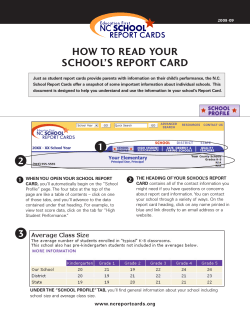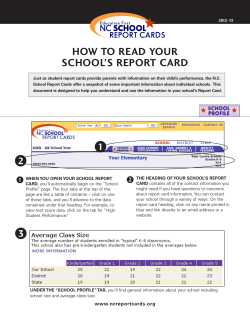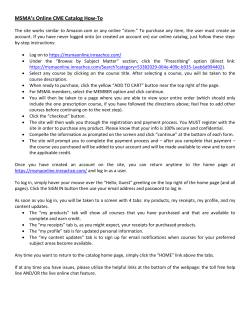
Phoenix/EIM© CONTENT MANAGEMENT - Sign In
PROJECT PHOENIX EduTrax Instructional Management Solution Phoenix/EIM© CONTENT MANAGEMENT QUICK GUIDE & ILLUSTRATED HELP Version 1.5.1.1 The content management module allows district administrative staff the ability to navigate into the content item bank and view questions by the specific curriculum alignment. QUICK GUIDE 1. 2. 3. 4. Login to the Phoenix web site and select Manage Item Content from the Assessment menu (Green). Using the mouse, open the desired folders based on the curriculum alignment desired. Continue drilling into the data until the desired level is reached. Question items will be listed with a blue question mark icon and the unique identifying ID number from the database. Click on the question text to view the item. 5. The panel displayed on the right side of the page will contain seven tabs of information: Preview – visual picture of the question including answers. Correct answer will have a checkmark in front of it. Details – the various pieces of information stored in the database about the item including the source, usage, difficulty, etc. Curriculum – the specific standard the item is tied to within the curriculum database Passage – if the item has an attached passage or diagram it may be displayed on this tab Rubric – if the vendor has provided a scoring rubric it will be displayed on this tab Assessments – any test created within the program that is using this item Stats – once an item has been used, various statistical values will be calculated and displayed on this tab 6. From the preview tab, you can quickly identify which of the other tabs contain data by noting the asterisk beside the tab name. 7. You can alter the current usage of the item (i.e. from Review to Open Use) by clicking on the appropriate link in the bottom option bar. Assessment – Content Management Page 2 ILLUSTRATED HELP GUIDE 1. Log into the Phoenix/EIM program and select the “Manage Item Content” option from the dropdown assessment menu. 2. The page will initially display a tree-type folder structure on the left side of the page. The initial folders will be listed as National, State, or District Standards. Typically the State Standards folder will contain the bulk of the items. Open the desired folder using the mouse and clicking on the plus sign icon to the left of the folder. Continue drilling into the structure based on the desired curriculum and standards desired. 3. The three rows of filters allow you to be very specific about which types of items you wish to view. Click on the desired checkboxes to filter the list. NOTE-- if you select any of the vendor options, all other types of items will be excluded. The toggle button will open and close the filter section. Assessment – Content Management Page 3 4. Once you have reached the desired curriculum and standard, any questions attached to the standard will be listed showing a blue question mark icon, as well as the unique database identification number. The first few lines of the question are shown to assist. Click on the question text to view the item in detail. A tabbed panel will open on the right showing the various types of data available. 5. The initial tab is the Preview tab. This tab will display the visual representation of the question, including any graphics attached. Multiple choice items will show the responses, with the correct answer identified by a checkmark. Assessment – Content Management Page 4 6. The second tab is the Details tab. This tab shows additional information for the item stored in the database. This includes a variety of data including the source of the item, how it can be used, how it is classified in terms of difficulty, etc. 7. The third tab is the Curriculum tab. This tab is a recap of the specific curriculum standards this item is aligned to. This would typically equate to the navigation structure used to reach the item. Assessment – Content Management Page 5 8. The fourth tab is the Passage tab. This tab will display any attached passage required for an item. This is generally a text-based reading passage, but may also be a large diagram or chart used by multiple questions. Assessment – Content Management Page 6 9. Tab number five is the Rubric tab. This tab is provided for those rubric-based items (i.e. constructed response) in which the item vendor has provided a scoring rubric to assist in evaluating a student’s response. The online scoring entry program will display this rubric for the teacher as they are entering the scores via the web site. Assessment – Content Management Page 7 10. Tab six is the Assessment tab. This tab will list every assessment that has been created using this item, including the question number on the test and the point value. 11. The last tab is the Stats tab. Once the item has been used on an assessment and scores recorded, a nightly process will perform some basic statistical calculations that will be listed here. 12. Note that the last four tabs (Passage, Rubric, Assessments, and Stats will all indicate that data is available on that tab by displaying an asterisk beside the tab name. This will allow easier determination of which tabs actually contain data for the item. 13. The last topic relates to the options available at the bottom of the right side tab panel. These options will be available based on the current status of the question being viewed and offer the ability to change the status of a question easily. Assessment – Content Management Page 8 14. Each item in the database, regardless of its source, is assigned a usage code, which determines how and where a question can be used. The following usage values are available: Under Review The item cannot be viewed or used in the test setup process by any users. This is the typical status when a batch of items is loaded (purchased items for instance). District staff must review the items and then activate them for general use. District Use These items are reserved for district staff and can be used to create district-level assessments (i.e. benchmarks, etc.) These items are not visible and cannot be used by school-based staff. Local School Use These items are created and entered into the database by teachers and other school staff and are typically used to construct school-based or classroom tests. Open for Use These items are available for use by any user for any purpose. NOTE—school based staff only have the option of creating and using Local School items. These items remain in this status permanently unless promoted to district use by district staff. Assessment – Content Management Page 9
© Copyright 2025









